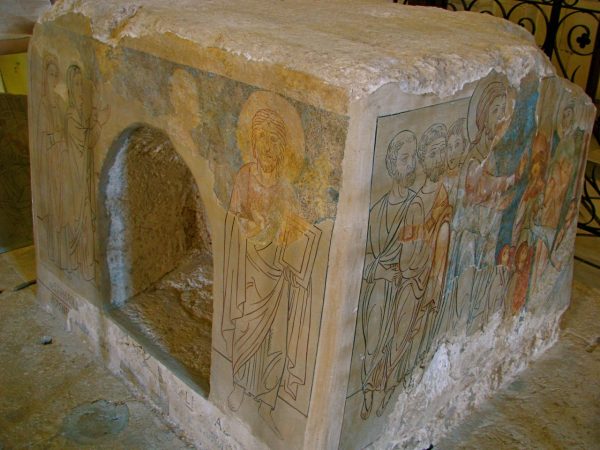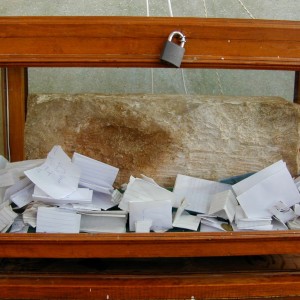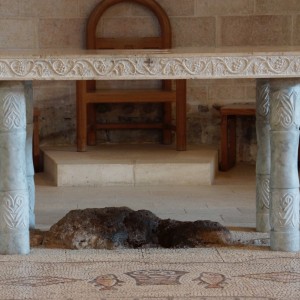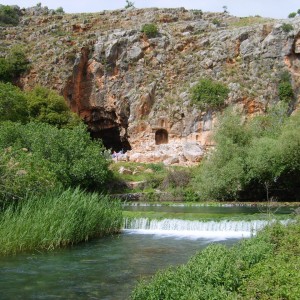See, your king comes to you, gentle and riding on a donkey, on a colt, the foal of a donkey. –Mt 21:5
When I first heard about the “Stele of Bethphage,” I laughed.
A commemorative stone purporting to be the rock on which Jesus stood in order to mount the donkey? Who needs a rock to get onto a donkey—and not even a full grown animal but a “foal”?
This amusing tradition brings up the question of how tall Jesus may have been. Based on nothing more than personal intuition, I tend to picture Him as unusually short. The only possible evidence for His height is the Shroud of Turin, which preserves the outline of a man about six feet tall, or possibly a few inches shorter. However, the figure appears elongated, especially the face and hands, as if the fabric has been stretched. People weren’t tall in those days, and I find it hard to imagine a Christ who would lord it over others through physical stature. Isaiah describes the messiah as having “no beauty or majesty to attract us to him, nothing in his appearance that we should desire him” (53:2). I like to think that when Jesus invited Himself to the house of Zaccheus, it was partly because He identified with the diminutive tax collector who had climbed a tree in order to see Him (Lk 19:3). Some sayings of Jesus gain an interesting note of irony if one thinks of Him as being short: for example, “Who of you by worrying can add a single cubit to his height?” (Mt 6:27), or, “The Son of Man must be lifted up” (Jn 3:14).
Short or tall, it’s unlikely that the King of kings needed the aid of a rock to mount a donkey. However, the Stele of Bethphage may still be authentic in marking the starting point of the Palm Sunday procession. Isn’t it possible that someone might remember this place and even take note of a particular stone? After all, it was a most remarkable event: A famous rabbi entering Jerusalem on the foal of a donkey was a clear proclamation of messiahship, recalling Zechariah 9:9 (quoted by Matthew at the head of this chapter). As early as David’s time, a coronation was celebrated by the new king riding into Jerusalem on a mule. When Solomon succeeded David, he mounted his father’s mule and “then they sounded the trumpet and all the people shouted, ‘Long live King Solomon!’ And all the people went up after him, playing flutes and rejoicing greatly, so that the ground shook with the sound” (1 Ki 1:39-40).
In the case of Jesus’ “coronation ride,” note the important difference that He chose not a sterile mule but a donkey, indeed a foal that had never been ridden. While Jesus seldom identified Himself in plain words as the coming King, in countless ways He demonstrated this truth, the Palm Sunday parade being a prime example. Indeed this event had all the trappings of a planned political demonstration: a colorful leader, enthusiastic followers, a volatile holiday crowd, and even a simultaneous opposition rally.
The opposition came from Pontius Pilate, the Roman ruler who in less than a week’s time would condemn the true Ruler to death. Pilate spent most of his time at a luxurious palace on the Mediterranean coast, but for festivals in the capital he took up residence in the Antonia Tower overlooking the Temple, where he could keep an eye on any potential trouble. At the approach of Passover—the celebration marking the Israelites’ liberation from an earlier empire—it is possible that as Jesus was parading into the city to the waving of palms (symbols of the revolutionary Maccabees), Pilate and his Roman cohort would have been marching from the opposite direction in honor of Caesar, their own “Son of God,” to “the creaking of leather, the clinking of bridles, the beating of drums.” (1)
So the stage was set: Even as the dark powers of the world entered the holy city from the west, from the east came the breaking light of the kingdom of God.
(1) I owe this speculation to Marcus Borg & John Dominic Crossan, The Last Week: What the Gospels Really Teach About Jesus’ Final Week in Jerusalem, HarperCollins Publishers, San Francisco, 2006, pp 2 ff.
Photo © Paul Laju
Next Week: Touching Jesus





